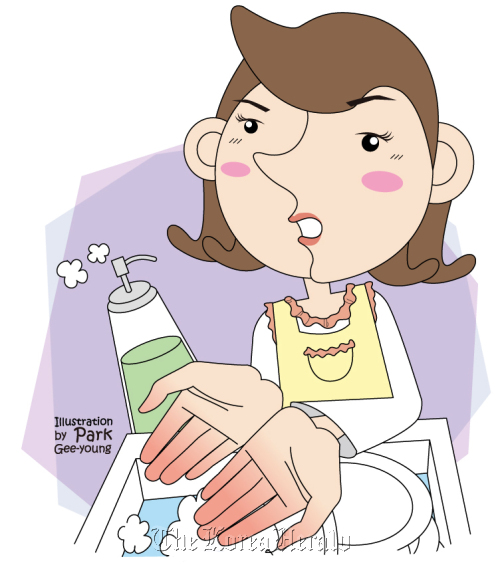Housewife’s eczema is a type of hand eczema named for its frequent occurrence among housewives.
In particular, it affects mothers who regularly engage in a wide range of chores that involve putting hands in water. The most common factor leading to this dermatitis is repeated exposure to and chronic irritation from water and synthetic detergents.
Housewife’s eczema, unlike other types of eczema, is not normally accompanied by itching. However, the affected skin at the fingertips may become thinner and show redness and scaling. As this disorder advances, it may result in cracking skin, pain and bleeding.
Housewife’s eczema commonly appears on the tips of the first, second and third fingers of the right hand due to more frequent use. In severe cases, it progresses down the fingers to the palm. It can lead to candidiasis of fingernails and secondary infections, causing pustules and pain in the fingernails.

Housewife’s eczema also frequently affects those with a history of atopic dermatitis.
Many patients diagnosed with this dermatitis are found to be allergic to rubber products, perfume and metal. Their hands become red and swollen and papules form when exposed to such allergens, interfering with treatment.
Patients suffering from recurrent hand eczema should arrange for patch tests to verify allergens.
Housewife’s eczema is a contact dermatitis resulting from a combination of causes.
The condition of the epidermis, the exposed regions of the skin, the age of the patient and the environmental factors (temperature and humidity) all play instrumental roles.
Although the skin is protected by a thin layer of fat that is also highly resistant of bacteria, when the hands come in contact with irritants such as detergents and soaps, this outer protective layer of the skin can be destroyed.
The result is dryness of the hands and cracking or thinning of the fingertip skin, especially the cuticles. This disorder is more likely to appear and recur frequently during the changing of seasons when the humidity is low.
It is critical to reduce exposure to water and detergents to prevent housewife’s eczema.
Make sure to wear cotton-lined rubber gloves or a separate pair of cotton gloves inside rubber gloves when engaged in “wet work.” Change the cotton gloves immediately when they become damp from sweat or moisture to keep the hands dry at all times. Try to keep exposure to water at a minimum by reducing the frequency of “wet work,” and seek treatment right after the onset of eczema to prevent further aggravation.
Once housewife’s eczema occurs, it should be treated immediately. Delayed treatment may lead to pain, cracking and secondary infections.
Treatment in earlier stages typically involves the application of emollients in association with creams or lotions containing a steroid. If secondary infections are found, a product with antibiotic and antifungal components should be used. Lotion treatments are easy to apply over a relatively wide area.
With advanced housewife’s eczema that exhibits crusting, a skin-softening ointment is prescribed, along with occlusion therapy to help the absorption of the medicine. If an allergic response to rubber, perfume, or metal is suspected, undergo patch tests to verify the allergen and avoid contact with the substance. Lastly, it is important for patients to disengage themselves from “wet work,” to let their hands rest and protect them with extra care at least until the dermatitis clears.
In particular, it affects mothers who regularly engage in a wide range of chores that involve putting hands in water. The most common factor leading to this dermatitis is repeated exposure to and chronic irritation from water and synthetic detergents.
Housewife’s eczema, unlike other types of eczema, is not normally accompanied by itching. However, the affected skin at the fingertips may become thinner and show redness and scaling. As this disorder advances, it may result in cracking skin, pain and bleeding.
Housewife’s eczema commonly appears on the tips of the first, second and third fingers of the right hand due to more frequent use. In severe cases, it progresses down the fingers to the palm. It can lead to candidiasis of fingernails and secondary infections, causing pustules and pain in the fingernails.

Housewife’s eczema also frequently affects those with a history of atopic dermatitis.
Many patients diagnosed with this dermatitis are found to be allergic to rubber products, perfume and metal. Their hands become red and swollen and papules form when exposed to such allergens, interfering with treatment.
Patients suffering from recurrent hand eczema should arrange for patch tests to verify allergens.
Housewife’s eczema is a contact dermatitis resulting from a combination of causes.
The condition of the epidermis, the exposed regions of the skin, the age of the patient and the environmental factors (temperature and humidity) all play instrumental roles.
Although the skin is protected by a thin layer of fat that is also highly resistant of bacteria, when the hands come in contact with irritants such as detergents and soaps, this outer protective layer of the skin can be destroyed.
The result is dryness of the hands and cracking or thinning of the fingertip skin, especially the cuticles. This disorder is more likely to appear and recur frequently during the changing of seasons when the humidity is low.
It is critical to reduce exposure to water and detergents to prevent housewife’s eczema.
Make sure to wear cotton-lined rubber gloves or a separate pair of cotton gloves inside rubber gloves when engaged in “wet work.” Change the cotton gloves immediately when they become damp from sweat or moisture to keep the hands dry at all times. Try to keep exposure to water at a minimum by reducing the frequency of “wet work,” and seek treatment right after the onset of eczema to prevent further aggravation.
Once housewife’s eczema occurs, it should be treated immediately. Delayed treatment may lead to pain, cracking and secondary infections.
Treatment in earlier stages typically involves the application of emollients in association with creams or lotions containing a steroid. If secondary infections are found, a product with antibiotic and antifungal components should be used. Lotion treatments are easy to apply over a relatively wide area.
With advanced housewife’s eczema that exhibits crusting, a skin-softening ointment is prescribed, along with occlusion therapy to help the absorption of the medicine. If an allergic response to rubber, perfume, or metal is suspected, undergo patch tests to verify the allergen and avoid contact with the substance. Lastly, it is important for patients to disengage themselves from “wet work,” to let their hands rest and protect them with extra care at least until the dermatitis clears.

By Lee Joo-heung MD., PhD.
The author is professor at the Department of Dermatology of Sungkyunkwan University School of Medicine. ― Ed.
-
Articles by Korea Herald

















![[KH Explains] Hyundai's full hybrid edge to pay off amid slow transition to pure EVs](http://res.heraldm.com/phpwas/restmb_idxmake.php?idx=652&simg=/content/image/2024/04/18/20240418050645_0.jpg&u=20240418181020)

![[Today’s K-pop] Zico drops snippet of collaboration with Jennie](http://res.heraldm.com/phpwas/restmb_idxmake.php?idx=642&simg=/content/image/2024/04/18/20240418050702_0.jpg&u=)